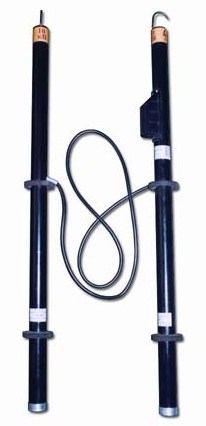Electrical safety devices for electrical installations with a voltage above 1000 V
Basic electrical safety measures in electrical installations
The main electrical protective devices in electrical installations with a voltage above 1000 V are insulating rods, insulating and electrical clamps, voltage indicators, as well as insulating devices and bodies for repair work (platforms, insulating connections of telescopic towers, etc.).
The insulating rods consist of three parts: the working part, which, depending on the purpose of the rod, is made in the form of a finger, grapple, cutter, brush, etc.; insulating, which serves to isolate the person working from the live part (the length of the insulating part is determined by the working voltage of the rod); grips to hold the barbell in your hands.
Depending on the destination, the rods are divided into operational, repair and measuring rods. Work insulating bars for distribution operations; devices — switching on and off the disconnector blades, check the degree of heating of live parts etc. Repair of insulating rods are used to perform work on live parts under voltage (cleaning insulators from dust, connecting temporary electrical receivers, tying wires, etc.). Measuring insulating rods is used to control the voltage distribution on individual insulators in garlands, as well as to measure the contact resistances of the contact connections.
Work with a barbell is allowed only by specially trained personnel in the presence of a person controlling the actions of the worker. When working with the insulating rod, it is necessary to use additional insulating protective means - dielectric gloves and insulating bases (stands, carpets) or dielectric boots.

Measuring clamp designed for measuring current without breaking the circuit. They consist of a current transformer with a split magnetic core and a secondary winding loaded with an ammeter, and handles of suitable length. Currently, current measuring clamps Ts90 (up to 10 kV) are used for currents up to 600 A. The rules for using current measuring clamps are the same as for insulating ones.
Voltage indicators are designed to detect the presence of voltage without measuring its value. Indicators for voltages above 1000 V are produced in two modifications: with a gas discharge indicator lamp, the principle of which is based on the glow of a gas discharge lamp when a capacitive current flows through it, and non-contact type, which work on the principle of electrostatic induction.
A voltage indicator with a discharge lamp consists of a working, insulating part and a handle.The working part includes a contact tip, a gas discharge lamp, the burning of which indicates the presence of voltage on the tested part of the electrical installation, and capacitors. Currently used indicators UVN-10 and UVN-80M (for electrical installations with voltage 2-10 kV) and UVN-90 (for electrical installations 35-110 kV). The non-contact high voltage indicator UVNB 6-35 kV is designed to determine the presence or absence of voltage on overhead lines, in switchgear for indoor and outdoor switchgear with a voltage of 6-35 kV. Its signal is the periodic glow of an incandescent lamp, and the frequency of the lamp's flashing increases as the pointer approaches live parts. The voltage signaling device of a separate SNI 6-10 kV is designed to warn a person of the presence of voltage when approaching the wires of an overhead line 6-10 kV at an unacceptable distance. Its signal is an interrupting sound, the frequency of interruption increases with the approach to the zone at an unacceptable distance, and in the zone itself the indication turns into a continuous sound; the signaling device refers to additional electrical protective equipment and cannot be used instead of voltage indicators.
Insulating pliers used in electrical installations up to 35 kV for live operations with fuses on tube fuses, as well as for placing and removing insulating caps on the blades of single-pole disconnectors.
When using insulating clamps, the operator must wear dielectric gloves and be isolated from the floor or soil; he must wear glasses when changing fuse holders.Pliers should be held in outstretched hands.
Additional electrical protective means in electrical installations
Additional insulating electrical protective equipment includes dielectric gloves, boots, rubber mats and walkways, porcelain insulated pads, and portable grounding.
Portable earthing devices are used to protect people working on disconnected live parts from erroneously applied or induced voltages. They consist of clamps for connecting to earthed conductors, a grounding wire for earthing and short-circuiting the live parts of all phases of the installation, and a clip or clamp for connecting to an earthing device or earthed structures.
Portable grounding with the help of special wires and clamps short-circuits live parts and connects them to the ground. They are made of flexible copper wire with a cross-section of conductors designed for thermal stability when short-circuit currents flow, but not less than 25 and 16 mm2 for electrical installations above 1000 V and up to 1000 V, respectively.
Applying a portable mass is carried out in the following sequence: first, the ground wire is connected to the grounding device, and then the short-circuit wires are applied to the phase wires. Remove the portable table in reverse order. Portable grounding operations are performed by the operator using an insulating rod wearing dielectric gloves, standing on an insulating base (mat or stand), or wearing dielectric boots.
